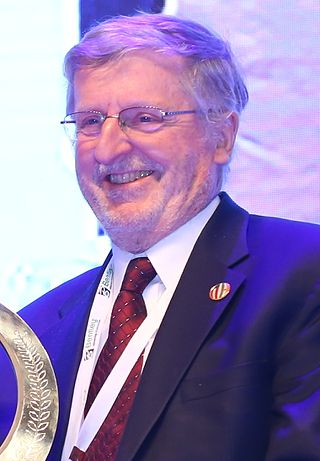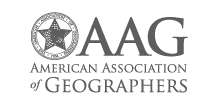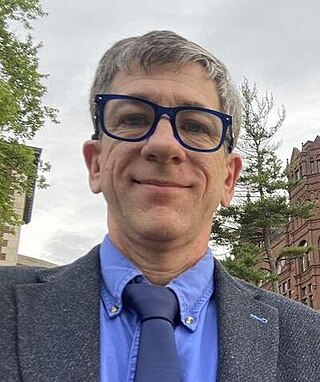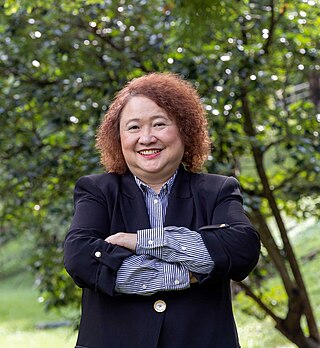Related Research Articles

A geographic information system (GIS) consists of integrated computer hardware and software that store, manage, analyze, edit, output, and visualize geographic data. Much of this often happens within a spatial database, however, this is not essential to meet the definition of a GIS. In a broader sense, one may consider such a system also to include human users and support staff, procedures and workflows, the body of knowledge of relevant concepts and methods, and institutional organizations.

New Mexico State University is a public land-grant research university in Las Cruces, New Mexico. Founded in 1888, it is the state's oldest public institution of higher education, and one of two flagship universities in New Mexico. NMSU has campuses in Alamogordo, Doña Ana County, and Grants, as well as research centers and programs in all 33 counties in the state.

Waldo Rudolph Tobler was an American-Swiss geographer and cartographer. Tobler is regarded as one of the most influential geographers and cartographers of the late 20th century and early 21st century. He is most well known for coining what has come to be referred to as Tobler's first law of geography. He also coined what has come to be referred to as Tobler's second law of geography.

Michael Frank Goodchild is a British-American geographer. He is an Emeritus Professor of Geography at the University of California, Santa Barbara. After nineteen years at the University of Western Ontario, including three years as chair, he moved to Santa Barbara in 1988, as part of the establishment of the National Center for Geographic Information and Analysis, which he directed for over 20 years. In 2008, he founded the UCSB Center for Spatial Studies.
Geographic information science or geoinformation science is a scientific discipline at the crossroads of computational science, social science, and natural science that studies geographic information, including how it represents phenomena in the real world, how it represents the way humans understand the world, and how it can be captured, organized, and analyzed. It is a sub-field of geography, specifically part of technical geography. It has applications to both physical geography and human geography, although its techniques can be applied to many other fields of study as well as many different industries.

Jack Dangermond is an American billionaire businessman and environmental scientist, who in 1969 co-founded, with Laura Dangermond, the Environmental Systems Research Institute (Esri), a privately held geographic information systems (GIS) software company. As of July 2023, his net worth was estimated at US$9.3 billion.

The American Association of Geographers (AAG) is a non-profit scientific and educational society aimed at advancing the understanding, study, and importance of geography and related fields. Its headquarters is located in Washington, D.C. The organization was founded on December 29, 1904, in Philadelphia, as the Association of American Geographers, with the American Society of Professional Geographers later amalgamating into it in December 1948 in Madison, Wisconsin. As of 2020, the association has more than 10,000 members, from nearly 100 countries. AAG members are geographers and related professionals who work in the public, private, and academic sectors.
The Geographic Information Science and Technology Body of Knowledge (GISTBoK) is a reference document produced by the University Consortium for Geographic Information Science (UCGIS) as the first product of its Model Curricula project, started in 1997 by Duane Marble and a select task force, and completed in 2006 by David DiBiase and a team of editors.

The International Cartographic Association (ICA) is an organization formed of national member organizations, to provide a forum for issues and techniques in cartography and geographic information science (GIScience). ICA was founded on June 9, 1959, in Bern, Switzerland. The first General Assembly was held in Paris in 1961. The mission of the International Cartographic Association is to promote the disciplines and professions of cartography and GIScience in an international context. To achieve these aims, the ICA works with national and international governmental and commercial bodies, and with other international scientific societies.

Geography is the study of the lands, features, inhabitants, and phenomena of Earth. Geography is an all-encompassing discipline that seeks an understanding of Earth and its human and natural complexities—not merely where objects are, but also how they have changed and come to be. While geography is specific to Earth, many concepts can be applied more broadly to other celestial bodies in the field of planetary science. Geography has been called "a bridge between natural science and social science disciplines."

Computer cartography is the art, science, and technology of making and using maps with a computer. This technology represents a paradigm shift in how maps are produced, but is still fundamentally a subset of traditional cartography. The primary function of this technology is to produce maps, including creation of accurate representations of a particular area such as, detailing major road arteries and other points of interest for navigation, and in the creation of thematic maps. Computer cartography is one of the main functions of geographic information systems (GIS), however, GIS is not necessary to facilitate computer cartography and has functions beyond just making maps. The first peer-reviewed publications on using computers to help in the cartographic process predate the introduction of full GIS by several years.

Joseph Kerski is a geographer with a focus on the use of Geographic Information Systems (GIS) in education.
Daniel Sui is a Chinese American geographer/GIScientist and currently serves as the senior president and chief research & innovation officer at Virginia Tech. Sui previously served as vice chancellor for research & innovation at the University of Arkansas – Fayetteville and division director for social & economic sciences at the U.S. National Science Foundation.

Mei-Po Kwan is a geographer known for her research contributions in Geographic Information Science, and human geography, particularly as they apply to time geography and human mobility. She is the Choh-Ming Li Professor of Geography and Resource Management at The Chinese University of Hong Kong (CUHK), Director of the Institute of Space and Earth Information Science (ISEIS) of CUHK, Director of the Institute of Future Cities of CUHK, and Head of Chung Chi College of CUHK.

Technical geography is the branch of geography that involves using, studying, and creating tools to obtain, analyze, interpret, understand, and communicate spatial information.
Brandon S. Plewe is a geographer and Associate Professor of geography at Brigham Young University.
Arthur Getis was an American geographer known for his significant contributions to spatial statistics and geographic information science (GIScience). With a career spanning over four decades, Getis authored more than one hundred peer-reviewed papers and book chapters, greatly influencing GIScience and geography as a whole. The Getis-Ord family of statistics, one of the most commonly used in spatial analysis, is based on his and J. Keith Ord's work and is still widely used in the creation of hot spot maps.
Alexander Stewart Fotheringham is a British-American geographer known for his contributions to quantitative geography and geographic information science (GIScience). He holds a Ph.D. in geography from McMaster University and is a Regents professor of computational spatial science in the School of Geographical Sciences and Urban Planning at Arizona State University. He has contributed to the literature surrounding spatial analysis and spatial statistics, particularly in the development of geographically weighted regression (GWR) and multiscale geographically weighted regression (MGWR).
Duane Francis Marble was an American geographer known for his significant contributions to quantitative geography and geographic information science (GIScience). Marble had a 40-year career as a professor at multiple institutions, retiring from the Ohio State University and holding a courtesy appointment as Professor of Geosciences at Oregon State University afterward. His early work was highly influential in computer cartography and is regarded as a significant contributor to the quantitative revolution in geography. His work on constructing a "Model Curricula" in GIScience is listed as the starting foundation built upon by the Geographic Information Science and Technology Body of Knowledge.
Michael P. Peterson is an American geographer and cartographer whose fields of research include Geographic information systems and computer cartography in relation to the Internet and World Wide Web. He has been a professor at the University of Nebraska Omaha since 1982. He was also the president of the North American Cartographic Information Society between 1996 and 1997, as well as the editor of the journal Cartographic Perspectives from 1998 to 2001.
References
- ↑ DeMers, Michael (20 Dec 2014). "President's Column: There's Geography in My Science". The Geography Teacher. 11 (1): 41–42. Bibcode:2014GeTea..11...41D. doi:10.1080/19338341.2013.854266. S2CID 140591678.
- 1 2 "Dr. Michael N. DeMers Bio". New Mexico State University Department of Geography. Retrieved 24 July 2022.
- 1 2 3 4 5 DeMers, Michael. "Dr. Michael DeMers Vita" (PDF). New Mexico State University Department of Geography. Retrieved 24 July 2022.
- 1 2 3 "MICHAEL DEMERS (2010 WINNER)" (PDF). American Association of Geographers. Retrieved 29 July 2022.
- ↑ DeMers, Michael (2009). GIS for Dummies. Hoboken, New Jersey: John Wiley and Sons Inc. ISBN 978-0-470-23682-6.
- 1 2 3 Campbell, Carol L. (2009). "Circle of Geographers: A History of the Geography Department at New Mexico State University". Southwestern Geographer. 13: 89–101. Retrieved 25 October 2023.
- 1 2 KRWG (February 29, 2012). "NMSU Geographer Works To Improve Geography Instruction In New Mexico Schools" . Retrieved 29 July 2022.
- ↑ DeMers, Michael (2009). Fundamentals of Geographic Information Systems (4th ed.). John Wiley & Sons, inc. ISBN 978-0-470-12906-7.
- 1 2 3 "Michael DeMers". University Consortium for Geographic Information Science. Retrieved 11 June 2023.
- ↑ Sparks, Jason (March 4, 2009). "Scott Simon Looks for Coffee in Second Life". NPR. Retrieved 29 July 2022.
- ↑ "Michael N. DeMers". Britannica. Encyclopædia Britannica, Inc. Retrieved 3 January 2024.
- ↑ DiBiase, David; DeMers, Michael; Johnson, Ann; Kemp, Karen; Luck, Ann Taylor; Plewe, Brandon; Wentz, Elizabeth (2006). Geographic Information Science and Technology Body of Knowledge. Association of American Geographers. ISBN 978-0-89291-267-4.
- ↑ Michael DeMers publications indexed by Google Scholar
- ↑ Fisher, Peter (2003). "Book Review: GIS Modeling in Raster". International Journal of Geographical Information Science. 17 (2): 200–201. doi:10.1080/713811746.
- ↑ Mesev, V (1999). "Reviews: Fundamentals of geographic information systems". Environment and Planning B: Planning and Design. 26 (2): 313–316. doi:10.1068/b260313.
- ↑ Sun-News Reports (11 May 2018). "NMSU professor receives lifetime achievement award". Las Cruces Sun-News. Retrieved 18 May 2024.
- ↑ Rundquist, Brad. "Dr. Michael DeMers to Receive Distinguished Alumnus". Department of Geography Alumni Newsletter Chair’s Corner. UNIVERSITY OF NORTH DAKOTA. Retrieved 29 July 2022.
- ↑ "AAG Anderson Medal Recipients". American Association of Geographers. Retrieved 24 July 2022.
- ↑ "Previous Anderson Medal of Honor Recipients". American Association of Geographers. Retrieved 29 July 2022.
- 1 2 "Awards and Scholarships". Department of Geography. New Mexico State University. Retrieved 24 October 2023.
- 1 2 3 "Young Vandar". Atmosphere Press. Retrieved 20 April 2023.